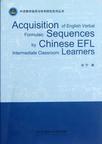中国学习者对于英语动词习惯性搭配的习得
出版时间:2012-7 出版社:北京理工大学出版社 作者:刘宁 页数:156 字数:175000
内容概要
《外语教学指导与学术研究系列丛书:中国学习者对于英语动词习惯性》主要内容包括:Chapter One:
Acquisition of Formulaic Sequences,Chapter Two: The Nature of
Formulaic Sequences and How to Learn and Teach Them,Chapter Three:
Study Questions and Methodology,Chapter Four: Data Analyses,Chapter
Five: Findings and Discussion,APPENDICES,References等。
作者简介
刘宁,1985年毕业于华中师范学院外语系英语语言文学专业,获得文学学士学位。1987-1988年在清华大学高级教师进修班攻读硕士研究生课程。1995年毕业于澳大利亚新南威尔士大学英语系,获得文学硕士学位。2012年毕业于英国西英格兰大学人文学院语言系,获得博士学位。
1985年以来,一直在北京理工大学任教,先后发表论文10多篇,出版各类书籍10多部,研究方向主要是英语语言测试和二语习得。
书籍目录
Introduction
Chapter One: Acquisition of Formulaic Sequences
1.1 First Language (Ll) Acquisition of Formulaic Sequences
1.2 Second Language (L2) Acquisition of Formulaic Sequences
Chapter Two: The Nature of Formulaic Sequences and How to Learn and
Teach Them
2.1 The Holistic and Analytic Features of Formulaic Sequences
2.2 The Transparency and Opaqueness of Formulaic Sequences
2.3 The Fixedness of Formulaic Sequences
2.4 The Processing of Formulaic Sequences
2.5 The Input of Formulaic Sequences for L2 Learners
2.6 Vocabulary Knowledge and Formulaic Sequences
2.6.1 What Is a Word?
2.6.2 What Does It Mean to Know a Word?
2.6.3 Measurement of Vocabulary Knowledge
2.6.4 Vocabulary Knowledge and Formulaic Sequences
2.7 Structural Differences Between English and Chinese Verbal
Formulaic Sequences
2.8 The Effect of Classroom Instruction on the Acquisition of
Formulaic Sequences
2.9 Overall Language Proficiency and Formulaic Sequences
2.10 Individual Differences and the Acquisition of Formulaic
Sequences
Chapter Three: Study Questions and Methodology
3.1 Hypotheses for the Present Study and Their
Operationalisations
3 .2 Methodology
3.2.1 Participants
3.2.2 Instruments and Procedures
3.2.2.1 Identifying the Target Verbal Formulaic Sequences
3.2.2.2 The English Verbal Formulaic Sequences Pre-test, Post-test
and Training Test
3.2.2.3 The Vocabulary-size Pre-test and Post-test
3.2.2.4 The Questionnaire
3.2.2.5 Survey of the Semantic Transparency/Opaqueness of the 100
Target English Verbal Formulaic Sequences
3.2.2.6 The Class Observations
3.2.2.7 The Participants' Essays
3.2.2.8 Survey of the Exposure to the 100 Target English Verbal
Formulaic Sequences.
Chapter Four: Data Analyses
4.1 Data Analyses for the Questionnaire
4.1.1 The Participants' Knowledge of English Verbal Formulaic
Sequences
4.1.2 The Participants' Report on Their Use of English Verbal
Formulaic Sequences
4.1.3 The Input of English Verbal Formulaic Sequences for the
Participants
4.1.4 The Output of English Verbal Formulaic Sequences of the
Participants
4.1.5 Summary.
4.2 Group Differences in Overall Proficiency, Vocabulary Size and
the Mastery of English Verbal Formulaic Sequences
4.2.1 Group Differences in Overall English Language
Proficiency
4.2.2 Group Differences in Vocabulary Size
4.2.2.1 The Vocabulary-size Pre-test
4.2.2.2 The Vocabulary-size Post-test
4.2,2.3 The Vocabulary Size Increase
4.2.3 Group Differences in the Mastery of English Verbal Formulaic
Sequences
4.2.3.1 The English Verbal Formulaic Sequences Pre-test
4.2.3.2 The English Verbal Formulaic Sequences Post-test
4.2.3.3 The English Verbal Formulaic Sequences Training Test
……
Chapter Five: Findings and Discussion
APPENDICES
References
章节摘录
Irujo (1986b) suggests four reasons for L2 learners' difficulties in learningidioms, the most fixed part of formulaic sequences. The first reason is thenon-literalness of idioms. Idioms are not literal and their meanings are not thecombinatory meanings of the constituent words. To make things worse, most idiomsalso have their literal counterparts, which make them even harder to learn. Forinstance, the verbal formulaic sequence to kick the bucket has an idiomatic meaning"to die", but it is also possible that someone really uses his foot to kick a containerof the type "bucket". A native speaker will quickly realise whether the literalmeaning or the idiomatic meaning of an idiom is intended in a certain context,while the L2 learners are left trying to figure out the figurative meaning from theliteral meanings of the constituent words. Furthermore, sometimes native-speakersuse idioms creatively to achieve some rhetoric effect such as irony, sarcasm andhumour, which "adds yet another layer of difficulty for the [L2] learner" (Prodromou 2007: 17). The second reason is the L2 learners' insufficient exposureto idioms. Idioms are frequently omitted in the speech addressed to L2 leamers(foreigner talk). Just as mothers use well-tailored caretaker speak to address theirchildren, native speakers tend to use simple, concrete, everyday vocabulary to address L2 learners. In most cases, the use ofidioms is either reduced or completelyavoided when addressing an L2 leamer (Henzl 1973; Kellerman 1977). In L2classroom settings, teacher talk rarely contains individual new words, about 2.75 new words per 500 words of speech (Schmitt 2008: 341), let alone the use of new formulaic sequences. Other one-way input like movies and radios, etc. is not helpful to the acquisition of such formulaic sequences because, for acquisition to occur, the learners need interactions in addition to input (Long 1982). The third reason lies in the correct use ofidioms. Even if L2 learners have mastered the meanings of someEnglish idioms, they still have difficulties in using them correctly according to situational appropriateness and grammatical constraints (Seidl and McMordie 1978). For example, although most verbal formulaic sequences are fixed sequences (likephrasal verbs), the verbs still need to be put in the correct tense form and the pronouns must agree with their antecedents. The last reason is that most teaching materials for L2 learners pay scarce attention to idioms. Idioms are either ignored completely or simply listed in the "fixed expressions" part of vocabulary lists,without providing sufficient exercises or other necessary aids (e.g. the vocabulary list in College English Curriculum Requirements (CECR) issued by the Educational Committee of China 2007). ……
图书封面
评论、评分、阅读与下载
